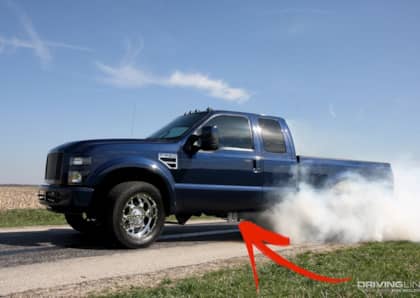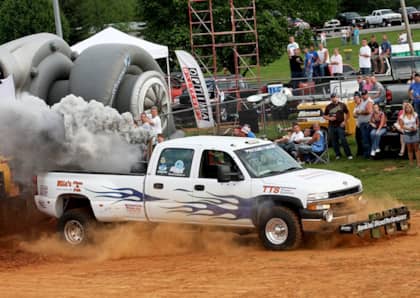Fueling Diesel Power: Why Your Truck Needs Dual Injection Pumps
The electronically controlled era of diesel engines has yielded some major breakthroughs in terms of performance, efficiency and cleanliness. Common-rail injection (a true marvel of modern fuel system technology) has made it possible to nearly double the power output of most Cummins, Duramax and Power Stroke mills with the use of a simple programmer. The oil burners of the 21st century are quieter, smoother, better refined and more powerful than any of their mechanical, electronic-over-mechanical or hydraulically-activated predecessors.
Still, every injection system has its limits. And, not unlike the fuel-delivery methods of yesteryear, the easiest way to add power (beyond what a programmer provides) is to add larger injectors.

When bigger injectors are coupled with computer calibrations that call for extended duration (injector on-time), the factory high-pressure fuel pump at the heart of the common-rail system can have a hard time keeping up. A common-rail pump’s main purpose is to produce extreme pressure (upward of 24,000 psi), which is then stored in the engine’s fuel rail(s) (hence the term “common-rail”). The injectors use this pressurized fuel as it’s required (commanded), but with larger injectors, more fuel from the rail is needed. This often leads to low rail pressure, high smoke levels, and poor performance when the pump can’t keep pace. The bottom line here is that low rail pressure means you’re leaving horsepower on the table—as much as 50 to 200 horsepower, depending on your modifications.
Because ample rail pressure must always be on tap for the injectors to use, enthusiasts have the option of installing a modified injection pump, but the cat’s meow is adding another pump to the engine. Often referred to as dual fuelers, twin CP3’s, or dual high-pressure fuel kits, two pump configurations are all the rage these days. Dual pump systems are usually belt-driven, capable of maintaining enough rail pressure to clear 1,000hp, and thanks to the pumps sharing the workload, they are extremely reliable.
Check out the method behind all the dual pump madness below.
In Bosch We Trust

The Bosch CP3 is the most frequently used injection pump on today’s high-pressure, common-rail diesel trucks. Reliability, high availability, and great performance potential are its primary strong suits. Slightly different versions of this pump came as standard equipment on ’01-’10 Duramax and ’03-present 5.9L and 6.7L Cummins engines. A 200,000-mile service life is usually guaranteed, but we’ve seen trucks with 700,000 miles on them still rocking the stock CP3!
Double Your Potential

On its own, the CP3 produces 24,000 to 26,000 psi of fuel pressure and can support a truck making approximately 550 horsepower at the wheels. When combined with a second (stock displacement) pump, the potential to make more than 1,000 horsepower is on the table. Such was the case with the LB7 Duramax shown here.
More Displacement, More Power

Larger displacement CP3 pumps also exist in the aftermarket, namely 10mm and 12mm “stroker” CP3’s from companies like Exergy Performance, Industrial Injection and Fleece Performance. These higher displacement pumps are often combined in mega-horsepower setups. With dual 12mm pumps, enthusiasts can support virtually any size injector or horsepower level they want.
Three’s Company

When you’re looking to push past 2,000 horsepower, sometimes not even two CP3 pumps are enough. This wild setup exists on Wes Kusilek’s Duramax-powered, sled pulling ’07 GMC 2500 HD, known nationally as “Cummins Killer.” Using a custom gearbox of his own design, three 10mm stroker CP3’s from Exergy Performance pressurize fuel, which is sent to one main fuel rail mounted above the gearbox before feeding eight very thirsty (large) injectors. The fuel system is controlled via a stand-alone ECU from Bosch Motorsports.
Two Brains Are Better Than One

Because no truck left the factory sporting two injection pumps, a controller of some kind has to be used when another CP3 is added to the mix. This small computer controls the second high-pressure pump in ATS Diesel’s Twin CP3 kit.
Newer Doesn’t Always Mean Better

With the ability to produce rail pressure as high as 30,000 psi, the Bosch CP4 injection pump (offered on the ’11-present LML Duramax and '11-'17 Ford 6.7L Power Stroke) is as efficient as it gets when it comes to meeting emissions and providing the most effective combustion event possible. While the CP4 took a step forward in terms of meeting the needs of OEM’s (as noted above, GM and Ford), it’s often viewed as a setback in the aftermarket. Long story short, the CP4 might be the industry’s latest and greatest, but it flows approximately 20-percent less than the CP3.
Power Stroking Pumps

Due to the Bosch CP4’s inability to support big horsepower (GM and Ford trucks equipped with them typically can’t crest the 500-rwhp mark), several aftermarket companies offer dual pump kits in which a CP3 is added. When combined with the stock CP4, the two pumps effectively share the job of creating 26,000 to 30,000 psi of rail pressure. This means each pump contributes 15,000 psi to the rail, making each unit’s service life much easier. A win-win combination: these systems add reliability and horsepower. The CP3 shown here resides on an ’11 Ford F-350 with the 6.7L Power Stroke, and came from H&S Motorsports.
Twinning!

Different from the Bosch common-rail systems found on Duramax and Cummins trucks of the same era, the 6.4L Power Stroke (built from '08-'10) uses a Siemens fuel system. While not as popular as the Bosch pumps, the Siemens K16 high-pressure pump outflows a comparable CP3 by 20 percent. When two are combined, the potential to make well north of 1,000 horsepower is on the table. Elite Diesel Engineering’s Twin K16 high pressure fuel system is shown above.
Larger Fuel Rails

While ported fuel rail fittings are the norm on Duramax and Cummins applications, all-out, larger capacity fuel rails are available for the 6.4L Power Stroke. Elite Diesel Engineering modifies these rails on its Stage 2 units to hold 25-percent more fuel than stock. The company’s kit also features a larger inlet and outlet. The idea behind a larger fuel rail is to have as much fuel on tap as possible in the rail waiting, so it can reach the injectors as quickly as possible.
Oil Pumping

Although they’re not technically called injection pumps, the same principal applies to HEUI injection engines that require high-pressure oil to activate the injectors. The goal is the same with these oil-fired engines: maintain more volume in the rail (oil rails in this) so longer duration (increased injector pulse width) can be used to make more power. On 7.3L engines, it’s typical for two factory high-pressure oil pumps to be stacked on top of each other, both of which are gear-driven. The image shown above illustrates where Full Force Diesel’s dual high-pressure oil pump kit resides at the front of a 7.3L Power Stroke. When dual pumps are employed on a 6.0L Power Stroke, it’s more common to find the second pump being belt-driven.











